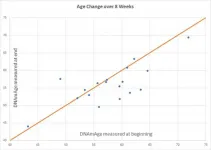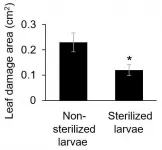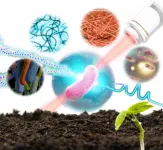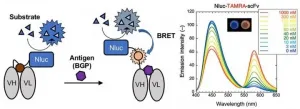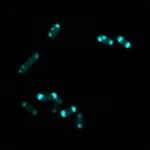INFORMATION:
The new species of bacteria killing palms in Australia
While investigating a disease outbreak in a Queensland botanical gardens, researchers discovered a new species of bacteria that causes a fatal disease in palms
2021-05-27
(Press-News.org) The bacterium, which they named Candidatus Phytoplasma dypsidis was found to cause a fatal wilt disease. This new discovery was reported in the International Journal of Systematic and Evolutionary Microbiology.
In 2016, several ornamental palms within a conservatory in the Cairns Botanic Gardens, Queensland, died mysteriously. A sample was taken from one of the diseased plants and investigated by Dr Richard Davis and colleagues from the Australian Government Department of Agriculture, Water and the Environment, and state and local government. They compared the characteristics and genome of the bacterium identified as the cause of the disease and found the bacterium was similar to other species of Candidatus Phytoplasma, many of which are responsible for disease epidemics in palms elsewhere but was different enough to be an independent species. "When the laboratory testing indicated it was something close to, but not the same as, devastating palm pathogens overseas, we were very surprised," said Dr Davis.
"At first we thought it was most likely an unrelated fungal disease. Almost as an afterthought, I suggested we screen for phytoplasma because there are some very bad phytoplasma diseases of palms moving around the world, including in neighbouring Papua New Guinea," he explained.
So far, infection with Candidatus Phytoplasma dypsidis has been found to cause disease in 12 different species of palms, including Cocos nucifera, which produces coconuts. "Although palms are not grown as a cash crop in Australia, they are important ornamental garden and amenity plants. Coconuts and other palms are an economically significant component of Australia's tourism industry in the tropics," said Dr Davis.
'Palms take on a much greater significance in most of the countries near Australia, in south east Asia and the Pacific, where coconuts are 'the tree of life'. It is important to raise awareness of a new disease threat, such as this, so that regional biosecurity measures can be prioritised."
The bacterium is thought to be spread from plant-to-plant by insects which feed on phloem, the tissue which transports nutrients around the plant, said Dr Davis: "it seems certain from our observations of how this thing has spread through the local area, that there must be an insect vector. Finding out what vector species are involved is a vital next research priority."
Outbreaks of exotic plant pathogens in Australia are rare due to the country's stringent biosecurity measures. "Australia, New Zealand and the Pacific island countries and territories have an enviable plant and animal health status compared to much of the rest of the world. Because we are islands, we have escaped many significant plant disease threats that have travelled around the world, over history," explained Dr Davis, "As biosecurity plant pathologists for the Australian Government Department of Agriculture, Water and the Environment, our team's main role is to look out for and detect incursions of exotic plant pathogens. We usually do this in remote parts of Australia's north, so to come across something much closer to home in the suburbs of Cairns, in far North Queensland, Australia, was unusual. However, we have no evidence to suggest this is an incursion from overseas because it is a unique organism. It may well be indigenous to Australia and some as yet unknown factor has triggered a disease outbreak."
Dr Davis is concerned that this new disease could spread outside of Cairns and affect palm populations further north: "North of Cairns, we have threatened ecological communities of fan palms which are of great environmental significance," he said. It is important for Dr Davis and his team to continue to monitor the spread of Candidatus Phytoplasma dypsidis. A number of questions remain, including which insect vectors are spreading the disease, and whether the bacterium is capable of infecting other types of plant, including important crops such as bananas.
ELSE PRESS RELEASES FROM THIS DATE:
Exploring optimization of duplex velocity criteria for diagnosis of ICA stenosis
2021-05-27
Study Exploring Optimization of Duplex Velocity Criteria for Diagnosis of Internal Carotid Artery (ICA) Stenosis Published Online
Online first in Vascular Medicine, researchers from the Intersocietal Accreditation Commission (IAC) Vascular Testing division report findings of their multi-centered study of duplex ultrasound for diagnosis of internal carotid artery (ICA) stenosis. 1
The study was developed in response to wide variability in the diagnostic criteria used to classify severity of ICA stenosis across vascular laboratories nationwide and following a survey of members of IAC-accredited ...
Aging: Clinical trial on potential reversal of epigenetic age using a diet and lifestyle
2021-05-27
Aging published "Potential reversal of epigenetic age using a diet and lifestyle intervention: a pilot randomized clinical trial" which reported on a randomized controlled clinical trial conducted among 43 healthy adult males between the ages of 50-72. The 8-week treatment program included diet, sleep, exercise and relaxation guidance, and supplemental probiotics and phytonutrients. Genome-wide DNA methylation analysis was conducted on saliva samples using the Illumina Methylation Epic Array and DNAmAge was calculated using the online Horvath DNAmAge clock (also published in Aging). The diet and lifestyle treatment was associated with a 3.23 years decrease in DNAmAge compared with controls. DNAmAge of those in the treatment group decreased by an average 1.96 ...
Books on health, economic inequalities in Latin America, Caribbean shed light on content, impact of health policies
2021-05-27
More than 500,000 people have died from COVID-19 in Latin America and the Caribbean, demonstrating the health and economic inequalities throughout the region. A new article analyzes seven books* that discuss these inequalities, including questions of who gets health care and what interdependent roles societies, social movements, and governments play. To end inequality in the region, the author calls for a universal approach to health care.
The article, by a professor at Carnegie Mellon University (CMU), appears in the June 2021 issue of Latin American Research Review, a journal published by the Latin American Studies Association.
"These books break new ground and contribute to our understanding of some of the most important health ...
Partners in crime: Agricultural pest that relies on bacteria to overcome plant defenses
2021-05-27
Although insect larvae may seem harmless to humans, they can be extremely dangerous to the plant species that many of them feed on, and some of those plant species are important as agricultural crops. Although plants cannot simply flee from danger like animals typically would, many have nonetheless evolved ingenious strategies to defend themselves from herbivores. Herbivorous insect larvae will commonly use their mouths to smear various digestive proteins onto plants that they want to eat, and when plants detect chemicals commonly found in these oral secretions, ...
Engineered defects in crystalline material boosts electrical performance
2021-05-27
AMES, Iowa - Materials engineers don't like to see line defects in functional materials.
The structural flaws along a one-dimensional line of atoms generally degrades performance of electrical materials. So, as a research paper published today by the journal Science reports, these linear defects, or dislocations, "are usually avoided at all costs."
But sometimes, a team of researchers from Europe, Iowa State University and the U.S. Department of Energy's Ames Laboratory report in that paper, engineering those defects in some oxide crystals can actually increase electrical performance.
The research team - led by Jürgen Rödel and Jurij Koruza of the Technical University of Darmstadt in Germany - found certain defects produce significant improvements in two key measurements ...
Researchers develop technique to functionally identify and sequence soil bacteria one cell at a time
2021-05-27
Researchers from the Single-Cell Center at the Qingdao Institute of Bioenergy and Bioprocess Technology (QIBEBT) of the Chinese Academy of Sciences have developed a technique to sort and sequence the genome of bacteria in soil one bacterial cell at a time, while also identifying what its function is in the soil environment.
Their study was published in the journal mSystems on May 27.
Soil is home to a vast and complex microbiome, which features arguably the highest genomic diversity and widest heterogeneity of metabolic activities of cells on Earth. In turn, these metabolic activities can in principle provide the foundation for industrial production of numerous compounds of value.
The ability to pinpoint ...
Shedding new light: A new type of immunosensor for immunoassay tests
2021-05-27
Immunosensors are widely used in immunoassays to detect antigens. One such immunosensor is a quenchbody (Q-body), which contains a modified antibody fragment with a quenched fluorescent dye. When an antigen binds to the Q-body, the dye leaves the antibody and the fluorescence intensifies. The change in fluorescence intensity is easy to measure, making Q-body-based antigen detection systems incredibly simple. However, this method requires an external light source to excite the electrons in the fluorescent dye to produce luminescence.
One way to solve this is to induce luminescence by an alternative method. To achieve this, researchers ...
Climate skeptics not easily persuaded by available evidence, now or later
2021-05-27
EUGENE, ORE. -- May 27, 2021 -- Climate skeptics who aren't persuaded by the existing evidence from climate change are unlikely to change their minds for many years, according to a newly published quantitative study by a University of Oregon environmental economist
The central question posed by the study published in the journal Climate Change was "How much evidence would it take to convince skeptics that they are wrong?" The answer depended on the degree of skepticism. The study modeled two types of hypothetical skeptics -- those who were less extreme and believed the change in temperature was slight, as well as ...
Not fear, but goal importance and others' behavior makes you favour COVID-19 measures
2021-05-27
While earlier research has mostly looked into factors such as fear, perceived risk, age and political views to determine what makes individuals and societies more or less willing to drastically change their lifestyle and support government-imposed strict restrictions, in order to mitigate the spread of the COVID-19 pandemic, psychologists at the University of Zurich Charlotte Kukowski, Katharina Bernecker and Veronika Brandstätter took a different perspective.
Instead, they chose to find out the impact of people's perception of others' behaviour when it comes to the public good, as well as people's own self-control in sticking to behaviour guidelines. By using data from the United Kingdom and Switzerland, they concluded that, ...
Fight against antibiotic-resistant bacteria has a glowing new weapon
2021-05-27
AUSTIN, Texas -- In the perpetual arms races between bacteria and human-made antibiotics, there is a new tool to give human medicine the edge, in part by revealing bacterial weaknesses and potentially by leading to more targeted or new treatments for bacterial infections.
A research team led by scientists at The University of Texas at Austin has developed chemical probes to help identify an enzyme, produced by some types of E. coli and pneumococcal bacteria, known to break down several common types of antibiotics, making these bacteria dangerously resistant to treatment.
"In response to antibiotic ...
LAST 30 PRESS RELEASES:
Tracing the quick synthesis of an industrially important catalyst
New software sheds light on cancer’s hidden genetic networks
UT Health San Antonio awarded $3 million in CPRIT grants to bolster cancer research and prevention efforts in South Texas
Third symposium spotlights global challenge of new contaminants in China’s fight against pollution
From straw to soil harmony: International team reveals how biochar supercharges carbon-smart farming
Myeloma: How AI is redrawing the map of cancer care
Manhattan E. Charurat, Ph.D., MHS invested as the Homer and Martha Gudelsky Distinguished Professor in Medicine at the University of Maryland School of Medicine
Insilico Medicine’s Pharma.AI Q4 Winter Launch Recap: Revolutionizing drug discovery with cutting-edge AI innovations, accelerating the path to pharmaceutical superintelligence
Nanoplastics have diet-dependent impacts on digestive system health
Brain neuron death occurs throughout life and increases with age, a natural human protein drug may halt neuron death in Alzheimer’s disease
SPIE and CLP announce the recipients of the 2025 Advanced Photonics Young Innovator Award
Lessons from the Caldor Fire’s Christmas Valley ‘Miracle’
Ant societies rose by trading individual protection for collective power
Research reveals how ancient viral DNA shapes early embryonic development
A molecular gatekeeper that controls protein synthesis
New ‘cloaking device’ concept to shield sensitive tech from magnetic fields
Researchers show impact of mountain building and climate change on alpine biodiversity
Study models the transition from Neanderthals to modern humans in Europe
University of Phoenix College of Doctoral Studies releases white paper on AI-driven skilling to reduce burnout and restore worker autonomy
AIs fail at the game of visual “telephone”
The levers for a sustainable food system
Potential changes in US homelessness by ending federal support for housing first programs
Vulnerability of large language models to prompt injection when providing medical advice
Researchers develop new system for high-energy-density, long-life, multi-electron transfer bromine-based flow batteries
Ending federal support for housing first programs could increase U.S. homelessness by 5% in one year, new JAMA study finds
New research uncovers molecular ‘safety switch’ shielding cancers from immune attack
Bacteria resisting viral infection can still sink carbon to ocean floor
Younger biological age may increase depression risk in older women during COVID-19
Bharat Innovates 2026 National Basecamp Showcases India’s Most Promising Deep-Tech Ventures
Here’s what determines whether your income level rises or falls
[Press-News.org] The new species of bacteria killing palms in AustraliaWhile investigating a disease outbreak in a Queensland botanical gardens, researchers discovered a new species of bacteria that causes a fatal disease in palms
